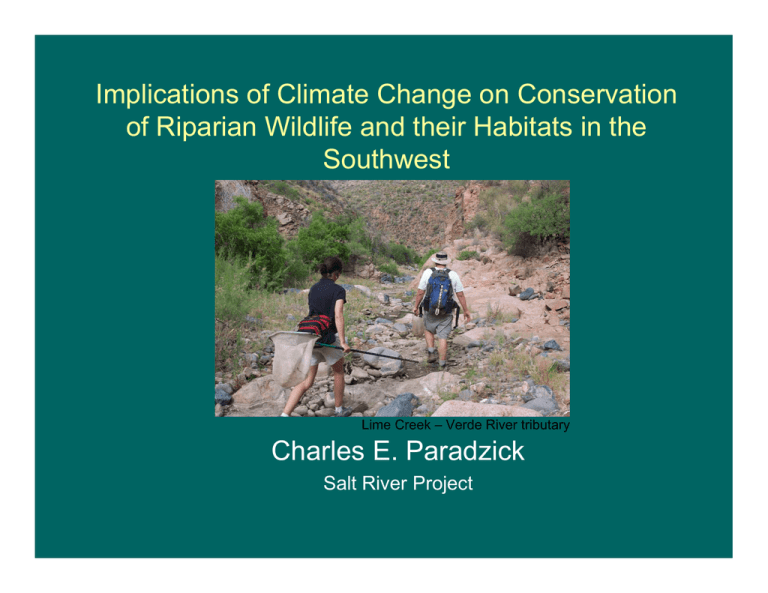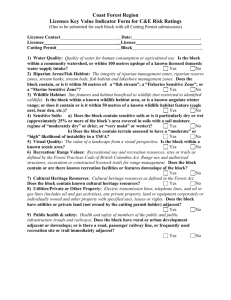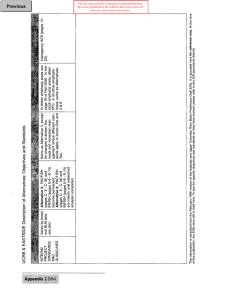Implications of Climate Change on Conservation Southwest
advertisement

Implications of Climate Change on Conservation of Riparian Wildlife and their Habitats in the Southwest Lime Creek – Verde River tributary Charles E. Paradzick Salt River Project • • • • • • • • Sabra Schwartz (AGFD) Bill Werner (ADWR) Mark Dixon (USD) Charlie Ester (SRP) Kathy Knoop (SRP) Rebecca Davison (AGFD) Craig Sommers (ERO) Troy Corman (AGFD) • Poff et al. (2002). Aquatic ecosystems and global climate change. Report for the Pew center on Global Climate Change • Grimm et al. (1997). Sensitivity of aquatic ecosystems to climatic and anthropogenic changes: the basin and range, American Southwest and Mexico. Hydrological Processes 11:1023-1041. Wildlife Manager’s Challenge fC ha ng e Channel Morphology Water Availability e nc Sc ale o Vegetation ue nfl cI oti Bi Animals Soil Quality Watershed conditions Long-term climate - hydrologic cycle Geology Modified from Long, J.W. 2002 NAU Dissertation Outline • Review potential climate change impacts on southwestern riparian and aquatic wildlife, fisheries, and habitats – Global ◊ local implications – What are the mechanisms for change? – What southwestern species and habitats are most vulnerable to a changing climate? • Management Implications – – Many more questions than answers. A Global Perspective • IPCC – April Report: – Changes to snow-fed rivers flow regime – Warming of lakes and rivers – changes to thermal structure and water quality – Species phenology - timing of recurring biological events – Changes in species ranges, abundance, and distribution • “Highway to extinction” Aquatic and Riparian Ecosystem Processes ↑ Air Temperature ↑ Water Temperature Poff et al. (2002) Δ Precipitation regime Δ Runoff Regime - magnitude - frequency - timing - duration Upland/watershed influence Existing and future threats/stressors Human responses Riparian/Aquatic Ecosystem Response - Organism metabolism - Nutrient supply, productivity, foodweb - Water quality - Habitat stability/suitability* - Δ Abundance & geographic range of species (+/-) Implications for Southwestern Species and Habitats • Grimm et al. (1997) - Sensitivity of SW Aquatic Ecosystems: • Hydrological and climatological models not yet sufficiently developed to predict magnitude or direction of changes to systems. – Biological models (quantitative analysis of relationships) are also lacking for many aquatic species (fish, amphibian) and terrestrial plant and wildlife species. • Conclusion: – Flow permanence – fragmentation, isolated systems – Thermal and hydrologic stability: springs, spring-fed streams – Geomorphic and biotic structure changes – desert rivers Species and Habitat Implications Temperature changes • Apache and Gila trout recovery? • Recreational fishing? • Future management of changing habitats? • Do we move species that are threatened to areas outside of their historic range? Predicted habitat loss of streams that could support cold-water trout (light shading) given a 3oC warming in July air temperatures. Keleher and Rahel (1996) in Poff et al. (2002) Species and Habitat Implications • • Flow Permanence – Isolated wetlands and riparian habitats, – Moisture thresholds – Secondary effects and scale considerations Timing, magnitude, duration, frequency of flow (floods and droughts) – Physical - Geomorphic changes – Changes to recruitment of riparian plants • Species composition & structural shift • Spatial and temporal considerations – Fish spawning cues Management Challenges The Salt Lake Tribune (1/2007): fC ha ng e Channel Morphology ue nfl cI oti Bi “Biologists with the Utah Division Animals of Wildlife Resources worry about global warming but remain more focused on Vegetation existing habitat problems. Sc ale o e nc Water Availability "Until we know what the possible impacts are, I don't know how we could address them," said Carmen Bailey, an Soil Quality amphibian specialist with the DWR. Watershed conditions climate - hydrologic cycle In the meantime, "Through time, Long-term things will be more specific. Geology we have to address immediate impacts." Management Challenges & Biological Information Needs • Watershed hydrological and vegetation prediction models • Species-habitat relationship models • Threat assessment and data needs (AFWA) Figur e Area – Recreation impacts • Identification and conservation of migration corridors (AGFD linkages project) - priority conservation lands • Baseline and future monitoring who, what, where, when, why? Willow flycatcher breeding habitat model. Dockens and Paradzick (2004) Management Challenges & Information Needs • Continue and increase coordinated planning with natural resources users (HCPs, State Conservation Plans) • Dialog: – Wildlife and land agency’s goals and objectives: Policy, legal, biology – Habitat and species conservation may be a moving target – what was suitable habitat today may not be in 10 years; priority setting. – Endangered species and critical habitat designations? LCR MSCP field trip Habitat conservation on the lower San Pedro River Current and past emphasis has been conservation and restoration of what was. Should this paradigm change to focus on what could be?







